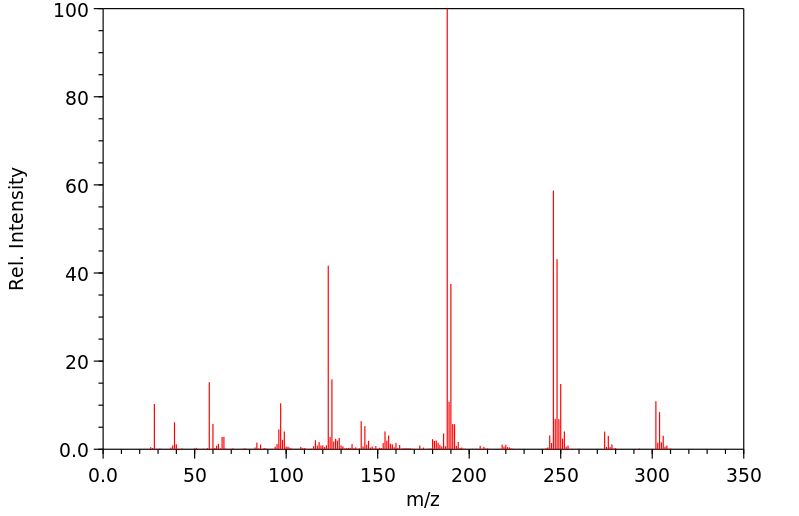[Ni(cyclopentadienyl)(μ-CO)]2
中文名称
——
中文别名
——
英文名称
[Ni(cyclopentadienyl)(μ-CO)]2
英文别名
{Ni(μ-CO)(η5-C5H5)}2;[(η(5)-C5H5)Ni(CO)]2;(π-C5H5)2Ni2(CO)2;(η5-C5H5)2Ni2(CO)2;Cp2Ni2(μ-CO)2;[CpNi(CO)]2
CAS
——
化学式
C12H10Ni2O2
mdl
——
分子量
303.59
InChiKey
LLHODUOKWVHGHM-UHFFFAOYSA-N
BEILSTEIN
——
EINECS
——
-
物化性质
-
计算性质
-
ADMET
-
安全信息
-
SDS
-
制备方法与用途
-
上下游信息
-
文献信息
-
表征谱图
-
同类化合物
-
相关功能分类
-
相关结构分类
计算性质
-
辛醇/水分配系数(LogP):1.96
-
重原子数:16
-
可旋转键数:0
-
环数:2.0
-
sp3杂化的碳原子比例:0.0
-
拓扑面积:2
-
氢给体数:0
-
氢受体数:2
反应信息
-
作为反应物:描述:[Ni(cyclopentadienyl)(μ-CO)]2 在 NO 作用下, 生成 cyclopentadienylnitrosylnickel(I)参考文献:名称:Gmelin Handbuch der Anorganischen Chemie, Gmelin Handbook: Ni: Org.Verb.2, 2.5.1.6.1, page 344 - 352摘要:DOI:
-
作为产物:描述:tetracarbonyl nickel 在 NaC5H5 、 Br2 作用下, 以 四氢呋喃 为溶剂, 以47%的产率得到[Ni(cyclopentadienyl)(μ-CO)]2参考文献:名称:Gmelin Handbuch der Anorganischen Chemie, Gmelin Handbook: Ni: Org.Verb.2, 2.5.1.6.1, page 344 - 352摘要:DOI:
文献信息
-
Intermetallic transfer of unsymmetrical borylene fragments: isolation of the second early-transition-metal terminal borylene complex and other rare species作者:Bret B. Macha、Debabrata Dhara、Krzysztof Radacki、Rian D. Dewhurst、Holger BraunschweigDOI:10.1039/d0dt03557b日期:——effectively transfer the borylene ligand to other transition metal complexes by replacing one or two carbonyl ligands upon irradiation of the reaction mixture with UV light. This borylene transfer reaction led to the formation of new terminal and bridging borylene complexes which cannot be formed by the corresponding salt elimination reactions, including a rare example of a bis(terminal borylene) complex
-
Syntheses of mixed transition metal clusters containing the coordinated phosphaalkyne tBuCP作者:Rainer Bartsch、John F. Nixon、Nigel SarjudeenDOI:10.1016/0022-328x(85)87476-3日期:1985.10Syntheses of the phosphaalkyne complexes [Ni2(η5-C5H5)2(tBuCP)] and [CoNi(η5-C5H5)(CO)3(tBuCP)] are described. Adducts of the latter with [W(CO)5] and [Mn(CO)2(η5-C5H5)] are also reported. The reactions of tBuCP with [CoMn(CO)9] or [RuCo2(CO)11] lead to the disproportionation products [Co2(CO)6(tBuCP)] and [Mn2(CO)10] or [Ru3(CO)10], respectively.
-
Synthesis of Triangular and Tetrahedral Heteronuclear Metal Clusters Using Hydride Complexes of Cyclopentadienylrhodium and -ruthenium as the Precursors作者:Takayuki Nakajima、Isao Shimizu、Kimiko Kobayashi、Yasuo WakatsukiDOI:10.1021/om970772c日期:1998.1.1Photochemical and/or thermal reactions of Cp*Rh(H)2(SiEt3)2 (Cp* = η5-C5Me5) with the dimeric metal complexes [CpNi(CO)]2 (Cp = η5-C5H5), [CpCo(NO)]2, [CpRu(CO)2]2, and [CpFe(CO)2]2 yielded the trinuclear complexes (Cp*Rh)(CpNi)2(CO)2 (3), (Cp*Rh)(CpCo)2(NO)2 (4), (Cp*Rh)(CpM)2(CO)4 (5a, M = Ru; 5b, M = Fe), respectively, while the reaction with [CpMo(CO)2]2 gave the tetranuclear unsaturated complex光化学和/或CP * Rh中的热反应(H)2(SIET 3)2(CP * =η 5 -C 5我5)与所述二聚的金属络合物[CPNI(CO)] 2(CP =η 5 -C 5 H 5),[CPCo(NO)] 2,[CPRu(CO)2 ] 2和[CPFe(CO)2 ] 2产生三核络合物(CP * Rh)(CPNi)2(CO)2(3),(CP * Rh)(CPCo)2(NO)2(4),(CP * Rh)(CPM)2(CO)4(5a,M = Ru; 5b,M = Fe),而与[CPMo(CO)2 ] 2的反应得到四核不饱和配合物(CP * Rh)2(CPMo)2(CO)4(6)以中等至中等的产量。同样,[CP * Ru] 2(μ-H)4与[CPNi(CO)] 2,CPCo(CO)2和[CPFe(CO)2 ] 2反应,得到四面体(CP * Ru)2(CPNi )2(CO)2(7),三角形(CP * R
-
Reaction of mesitylenetetracobaltnonacarbonyl with [Mo(CO)3C5H5]2. Syntheses and structures of the clusters C5H5(CO)2MoCo3(CO)6(μ-CO)3 and (C5H5)2(CO)3Mo2Co2(CO)4(μ-CO)3作者:V.S. Kaganovich、Yu.L. Slovokhotov、A.V. Mironov、Yu.T. Struchkov、M.I. RybinskayaDOI:10.1016/0022-328x(89)87228-6日期:1989.8Interaction of (mesitylene)Co4(CO)9 (I) with [Mo(CO)3Cp]2 (II) has been shown to result on a mixture of clusters Cp(CO)2MoCo3(CO)6(μ-CO)3 (III) and Cp2(CO)3Mo2Co2(CO)4(μ-CO)3 (IV). Complexes III and IV have also been obtained by an independent synthesis from Co2(CO)8 and II, the latter route is the most convenient and the simplest for the synthesis of III. X-ray diffraction studies on III and IV reveal已显示(1,3,5-三甲基)Co 4(CO)9(I)与[Mo(CO)3 Cp] 2(II)的相互作用是由于簇Cp(CO)2 MoCo 3(CO)6(μ -CO)3(III)和Cp 2(CO)3 Mo 2 Co 2(CO)4(μ-CO)3(IV)。配合物III和IV也可以通过Co 2(CO)8的独立合成获得和II,后一种路线对于III的合成是最方便和最简单的。对III和IV的X射线衍射研究表明,用Mo(CO)2 Cp基团连续替换Co 4四面体中的Co原子会导致簇的金属核发生相当大的变形。
-
Nickel−Manganese Sulfido Carbonyl Cluster Complexes. Synthesis, Structure, and Properties of the Unusual Paramagnetic Complexes Cp<sub>2</sub>Ni<sub>2</sub>Mn(CO)<sub>3</sub>(μ<sub>3</sub>-E)<sub>2</sub>, E = S, Se作者:Richard D. Adams、Shaobin Miao、Mark D. Smith、Horatio Farach、Charles Edwin Webster、Josiah Manson、Michael B. HallDOI:10.1021/ic0354419日期:2004.4.1The reaction of Mn(2)(CO)(7)(mu-S(2)) with [CpNi(CO)](2) yielded the paramagnetic new compound Cp(2)Ni(2)Mn(CO)(3)(mu(3)-S)(2) (1) and a new hexanuclear metal product Cp(2)Ni(2)Mn(4)(CO)(14)(mu(6)-S(2))(mu(3)-S)(2) (2). Structurally, compound 1 contains two triply bridging sulfido ligands on opposite sides of an open Ni(2)Mn triangular cluster. EPR and temperature-dependent magnetic susceptibilityMn(2)(CO)(7)(mu-S(2))与[CpNi(CO)](2)的反应产生顺磁性新化合物Cp(2)Ni(2)Mn(CO)(3 )(mu(3)-S)(2)(1)和新的六核金属产物Cp(2)Ni(2)Mn(4)(CO)(14)(mu(6)-S(2)) (mu(3)-S)(2)(2)。在结构上,化合物1在一个开放的Ni(2)Mn三角形簇的相对侧上包含两个三联桥接的硫键配体。EPR和1随温度变化的磁化率测量表明,它包含一个不成对的电子。1的电子结构由Fenske-Hall分子轨道计算确定,该计算表明未配对的电子占据了三个金属原子上不均等离域的低位反键轨道。硒同系物Cp(2)Ni(2)Mn(CO)(3)(mu(3)-Se)(2)(3)从Mn(2)(CO)(10 )和[CpNi(CO)](2)与元素硒和Me(3)NO.2H(2)O。它也有一个不成对的电子。化合物1与元素硫反应生成二镍二锰化合物C
表征谱图
-
氢谱1HNMR
-
质谱MS
-
碳谱13CNMR
-
红外IR
-
拉曼Raman
-
峰位数据
-
峰位匹配
-
表征信息
同类化合物
高密聚乙烯
香叶醇
顺式3-甲基-2-己烯
顺式-5-癸烯
顺式-5-甲基-2-己烯
顺式-5-庚烯-1-炔
顺式-4-癸烷
顺式-4-甲基-2-戊烯
顺式-4-甲基-2-戊烯
顺式-3-癸烯
顺式-3-甲基-3-己烯
顺式-3-甲基-2-庚烯
顺式-3-戊烯-1-炔
顺式-3,4-二甲基-3-己烯
顺式-3,4-二甲基-2-戊烯
顺式-3,4-二甲基-2-戊烯
顺式-2-甲基-3-己烯
顺式-2-壬烯
顺式-2-丁烯-D1
顺式-1.1.1-三甲基-2-丁烯
顺式-1-甲基-2-环丙基乙烯
顺式-1-甲基-2-乙烯基环戊烷
顺式-1-环戊基-1-辛烯
顺式-1-氘代-3-甲基-1-丁烯
顺式-(9ci)-2,3,3a,7a-四氢-4-(1-甲基乙基)-1H-茚
顺式-(2-丁烯基)环丙烷
顺式,顺式-2,4-己二烯
顺-环辛烯
顺-9-二十一碳烯
顺-6-十三碳烯
顺-5-甲基-1,3,6-庚三烯
顺-4-辛烯
顺-4-壬烯
顺-3-辛烯
顺-3-甲基-2-戊烯
顺-3-壬烯
顺-3-十三碳烯
顺-2-辛烯
顺-2-癸烯
顺-2-戊烯
顺-2-庚烯
顺-2-己烯
顺-2-丁烯
顺-2,2-二甲基-3-己烯
顺-1,3-戊二烯
顺,顺-1,9-环十六烷二烯
顺,顺,顺-环癸-1,3,5-三烯
间戊二烯
间二(4-吡啶基)苯
镁,二-2-丁烯基-







